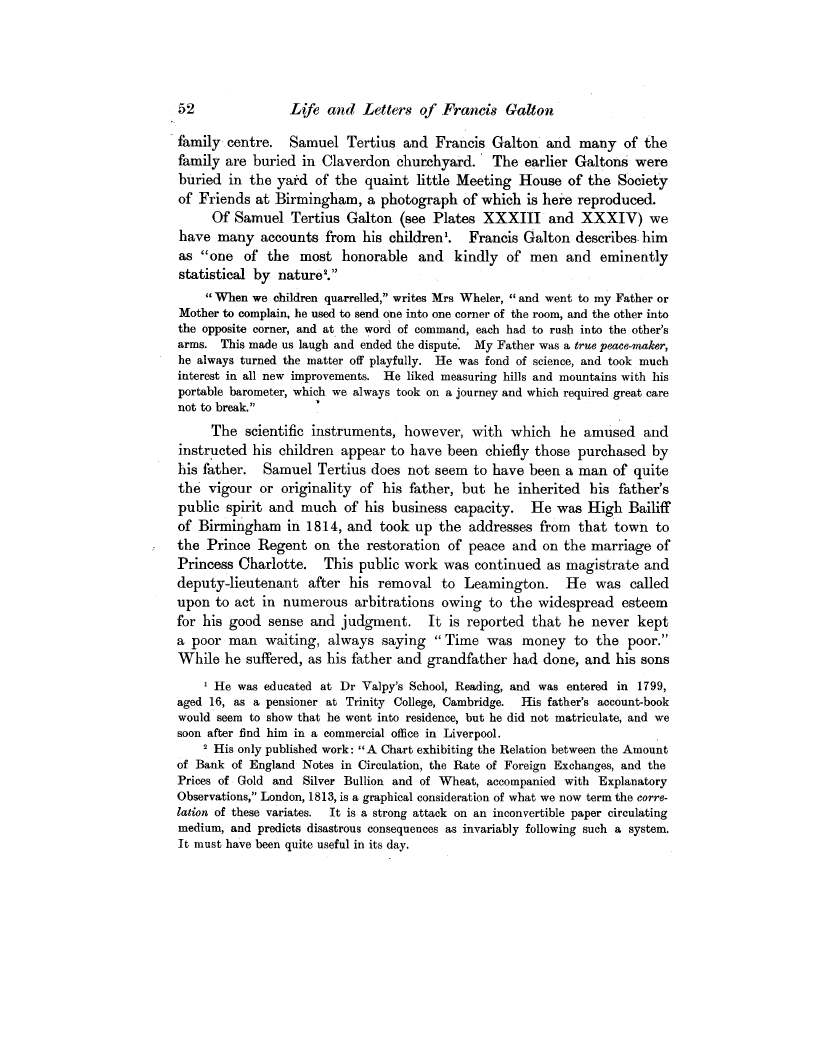| ||||||

OCR Rendition - approximate
52 Life and Letters of Francis Galton family- centre. Samuel Tertius and Francis Galton and many of the family are buried in Claverdon churchyard.' The earlier Galtons were buried in the yard of the quaint little Meeting House of the Society of Friends at Birmingham, a photograph of which is here reproduced. Of Samuel Tertius Galton (see Plates XXXIII and XXXIV) we have many accounts from his children'. Francis Galton describes him as "one of the most honorable and kindly of men and eminently statistical by nature2." " When we children quarrelled," writes Mrs Wheler, " and went to my Father or Mother to complain, he used to send one into one corner of the room, and the other into the opposite corner, and at the word of command, each had to rush into the other's arms. This made us laugh and ended the dispute. My Father was a true peace-maker, he always turned the matter off playfully. He was fond of science, and took much interest in all new improvements. He liked measuring hills and mountains with his portable barometer, which we always took on a journey and which required great care not to break." The scientific instruments, however, with which he amused and instructed his children appear to have been chiefly those purchased by his father. Samuel Tertius does not seem to have been a man of quite the vigour or originality of his father, but he inherited his father's public spirit and much of his business capacity. He was High Bailiff of Birmingham in 1814, and took up the addresses from that town to the Prince Regent on the restoration of peace and on the marriage of Princess Charlotte. This public work was continued as magistrate and deputy-lieutenant after his removal to Leamington. He was called upon to act in numerous arbitrations owing to the widespread esteem for his good sense and judgment. It is reported that he never kept a poor man waiting, always saying " Time was money to the poor." While he suffered, as his father and grandfather had done, and his sons 1 He was educated at Dr Valpy's School, Reading, and was entered in 1799, aged 16, as a pensioner at Trinity College, Cambridge. His father's account-book would seem to show that he went into residence, but he did not matriculate, and we soon after find him in a commercial office in Liverpool. His only published work: "A Chart exhibiting the Relation between the Amount of Bank of England Notes in Circulation, the Rate of Foreign Exchanges, and the Prices of Gold and Silver Bullion and of Wheat, accompanied with Explanatory Observations," London, 1813, is a graphical consideration of what we now term the correlation of these variates. It is a strong attack on an inconvertible paper circulating medium, and predicts disastrous consequences as invariably following such a system. It must have been quite useful in its day.
|